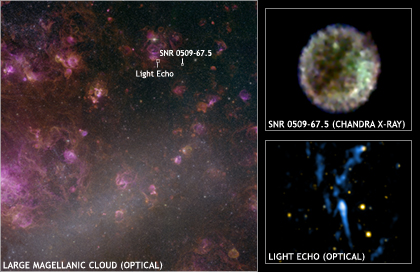Having A Light Go On: A New Way To Study Supernovas
Dr. Carles Badenes is a Chandra postdoctoral fellow at Princeton, having spent the previous few years at Rutgers University. His main research focus is on supernova explosions and supernova remnants, particularly the class known as Type Ia.
------------------------
This story began in February of 2007, when I was attending a scientific program on Type Ia supernova (SNe) at the Kavli Institute for Theoretical Physics in Santa Barbara. I knew about the light echoes from the three young Type Ia supernova remnants (SNRs) in the Large Magellanic Cloud (LMC) from the Nature paper that Armin Rest at Harvard and the superMACHO collaboration published in 2005. In fact, I had even used the age estimates for the SNRs that they derived from the echoes in a paper. But in Santa Barbara I listened to a very nice presentation by a member of the superMACHO team, Tom Matheson, describing how they had used the Gemini South telescope to extract spectra from one of the light echoes associated with a SNR called 0509-67.5. Tom showed us the optical spectrum of a 400 year-old supernova, and it nearly blew my socks off.

I have devoted most of my scientific career to extract information about Type Ia SN explosions from the X-ray observations of SNRs. Many times, when I was presenting my results at scientific conferences, my colleagues politely reminded me that the techniques I used were different and unfamiliar to them. After all, SNe are primarily studied and classified by looking at the optical light they emit, not at leftover X-ray emitting gas shocked by supersonic sound waves hundreds of years after the explosion. In principle, there is no way to calibrate the results of one technique with the other, because you have to wait for centuries for the SNR to form.
When I heard Tom's talk, I immediately realized that this situation had changed. I dropped the project I was working on at the time and started looking at the dynamics and X-ray spectrum of SNR 0509-67.5. All through the summer, we worked at Rutgers while Armin and his collaborators worked at Harvard. Bit by bit, a consistent picture started to come out of our work. We were seeing evidence for a highly energetic, iron-rich explosion from the SNR, and Armin and company were seeing a spectrum that looked a lot like the known examples of a subclass of Type Ia SNe known to be overluminous, energetic, and iron-rich. It was the first time that this kind of analysis can be done both on the SNR and the light from the SN. Thanks to the light echoes and Armin's work, we have been able to calibrate our techniques to extract the SN parameters from the X-ray emission of SNRs. I have to confess that I never thought this would be possible, but I am very glad that I was wrong!
-Carles Badenes
